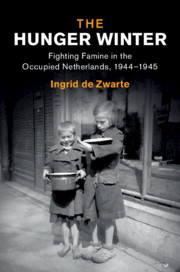Book contents
- The Hunger Winter
- Studies in the Social and Cultural History of Modern Warfare
- The Hunger Winter
- Copyright page
- Dedication
- Contents
- Illustrations
- Figures
- Maps
- Tables
- Acknowledgements
- Abbreviations
- Maps
- Introduction
- 1 Historical Contexts
- 2 Causes of the Famine
- 3 Effects on Mortality, Fertility, and Health in Later Life
- 4 Central Government and Food Administration
- 5 The Politics and Practices of Allied Relief
- 6 Coping at Household and Individual Levels
- 7 Community Strategies
- 8 The Evacuation of Children
- Conclusion
- Appendix: Timeline of Important Events
- Bibliography
- Index
2 - Causes of the Famine
Published online by Cambridge University Press: 04 July 2020
- The Hunger Winter
- Studies in the Social and Cultural History of Modern Warfare
- The Hunger Winter
- Copyright page
- Dedication
- Contents
- Illustrations
- Figures
- Maps
- Tables
- Acknowledgements
- Abbreviations
- Maps
- Introduction
- 1 Historical Contexts
- 2 Causes of the Famine
- 3 Effects on Mortality, Fertility, and Health in Later Life
- 4 Central Government and Food Administration
- 5 The Politics and Practices of Allied Relief
- 6 Coping at Household and Individual Levels
- 7 Community Strategies
- 8 The Evacuation of Children
- Conclusion
- Appendix: Timeline of Important Events
- Bibliography
- Index
Summary
Chapter 2 explains how the famine, which arose in the still-occupied western Netherlands after the Allies had liberated the southern part of the country, was caused and exacerbated by a complex culmination of various transportation and distribution problems. Interestingly, for the larger part it was not the overarching conflict between German and Dutch-Allied administrations, but a series of internal disputes and negotiations that influenced the course of the famine.
- Type
- Chapter
- Information
- The Hunger WinterFighting Famine in the Occupied Netherlands, 1944–1945, pp. 43 - 59Publisher: Cambridge University PressPrint publication year: 2020

